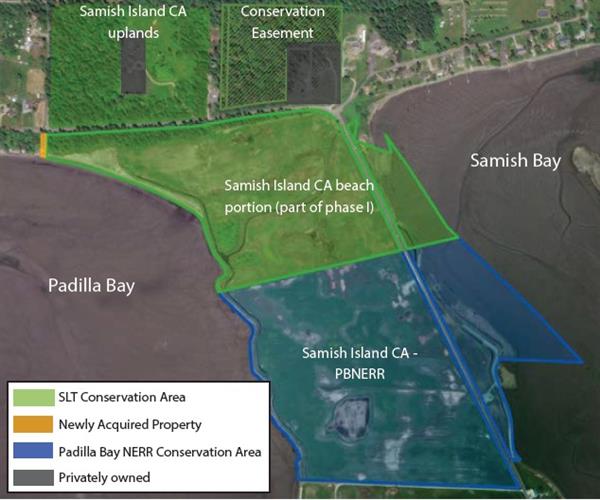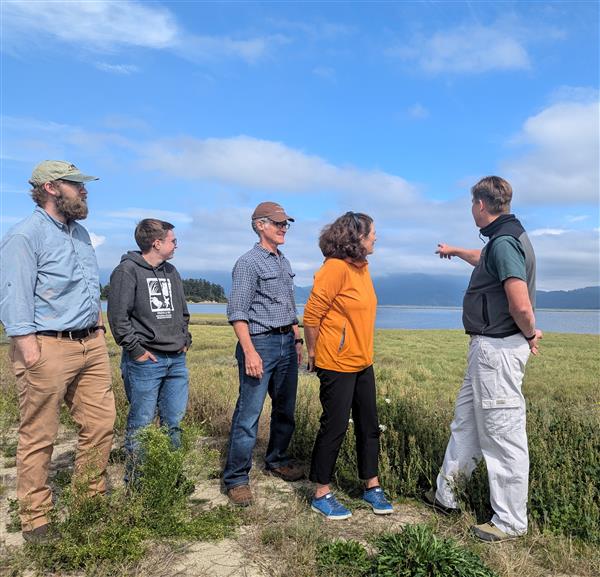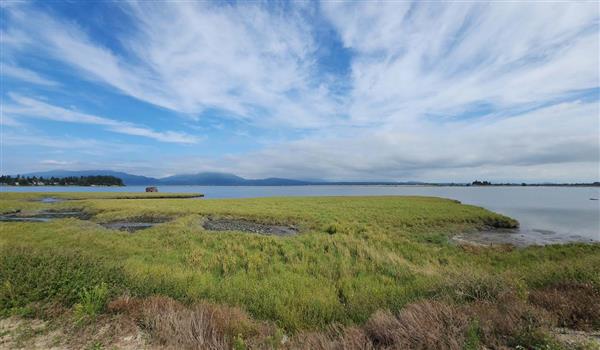This summer Skagit Land Trust (the Trust) added 50 feet of shoreline on Padilla Bay to our Samish Island Conservation Area with help from a federal National Coastal Wetlands Conservation Grant as well as Trust reserve funds. This latest addition continues a decades-long effort to conserve the forested uplands and approach via an isthmus to Samish Island.

“This Conservation Area is a wonderfully diverse ecosystem with old growth forest, wetlands, and former salt marsh habitat. This addition protects more shoreline, expands beach access, and allows us to think even more broadly about how to best steward and restore habitat,” says Kari Odden, one of the Trust’s Conservation Project Managers.
The area, stewarded by the Coast Salish people for thousands of years, once contained extensive salt marsh habitat before dike construction in the late 19th and early 20th centuries. A wide slough ran through the marsh near Samish Island and was used by the Samish people to reach their village, A7ts’iquen. According to the Samish Indian Nation historical timeline, the Samish left this village in the 1870’s after the planks and beams of their longhouse were taken by settlers.
Todd Woodard, Infrastructure and Resources Executive Director for the Samish Indian Nation, emphasizes the cultural significance of habitat protection and restoration: “The protection and restoration of habitat is important to the Samish People because of their cultural connection to salmonids and all that they support. “
The land at the entrance to the Island was managed by the Stewart/Murphy and Squires families for over a century. Skagit Land Trust worked with many generations of the two families to get this land conserved. Thanks to the families, community donations, project partners, as well as federal, state, and private grants, 156 acres and 1.4 miles of marine shoreline have been protected here.
A unique aspect of the conserved land is its tidal marsh. Of the 7,000 acres of historic tidal marsh and tidal swamp that buffered Padilla Bay, less than 3% remain. In 2022, Skagit Land Trust and the Padilla Bay National Estuarine Research Reserve (PBNERR) began a partnership to explore the possibility of restoring tidal marsh. Last year, PBNERR received grant funding from the National Oceanic and Atmospheric Administration to purchase 74.5 acres from the Skagit Land Trust just south of the Samish Island Conservation Area. Together, the Reserve and Skagit Land Trust are now exploring viability and options for salt marsh restoration on their properties. The two partners have hired Blue Coast Engineering to help them assess this.
.jpg&size=600)
“We’re excited to collaborate with Skagit Land Trust, Samish Indian Nation, dike & drainage districts, Skagit County, farmers, neighbors, shellfish growers, and the Samish Island community to restore salt marsh habitat on the Samish Isthmus,” says PBNERR Director Dr. Jude Apple. “This habitat is vital for supporting a diverse range of ecologically and economically important species, including Dungeness crabs, juvenile salmon, and herons. We’re committed to working closely with our partners to develop a restoration plan that benefits and balances ecosystem, community, and cultural values.”
Marsh habitat provides critical wildlife habitat and helps protect developed land from coastal flooding. It is one of the most powerful storage systems for carbon and is vital for many at-risk and endangered species. The small amount of tidal marsh that remains in Padilla and Samish Bays is at risk from sea-level rise, storm surges, and armoring of shorelines. Restoring tidal wetlands and shallow nearshore areas on the Samish Isthmus will provide habitat for numerous marine species, native fish, birds, and native plants.
The restoration project can also help with community resilience. The dikes on this part of the isthmus were never systematically maintained and are in poor condition. Saltwater intrusion has caused concern for farmers. The road which serves Samish Island is below sea level and will flood more frequently with sea-level rise. Working with the community and partners including the Dike District and Skagit County, this project can assist in improving local resilience and reducing the threat of road closures due to coastal flooding. A restoration project may assist in elevating the road and/or improving dikes.
Green infrastructure such as tidal marsh can reduce vulnerability to coastal flooding and sea level rise while offering a sanctuary for wildlife and providing educational opportunities to view nature. The project will ensure that local drainage is maintained or improved for the agricultural lands and residences to the south.

SLT and PBNERR staff on the dike, discussing the project
“During 2021 and 2022, our district experienced the most devastating coastal storms since its formation in 1890. Such incidents are likely to continue due to the threats posed by climate change and sea-level rise,” says Norm Hoffman, Dike District 5 Commissioner. “The feasibility and planning work is essential to protecting and restoring important natural systems in a way that ensures that critical infrastructure such as roads, dikes, and existing agriculture are protected.”
The restoration project, if determined to be viable, will take up to a decade to complete. The partners are currently in Phase I, which is Acquisition, Visioning, and Site Assessment. Skagit Land Trust, PBNERR, and Blue Coast Engineering have begun presenting their Phase I
findings to partners and affected parties.
Click here to view a PDF of the Blue Coast Engineering's presentation of their research findings and conceptual restoration ideas for the isthmus to Samish Island.
Click here to read the full report from Blue Coast Engineering.
